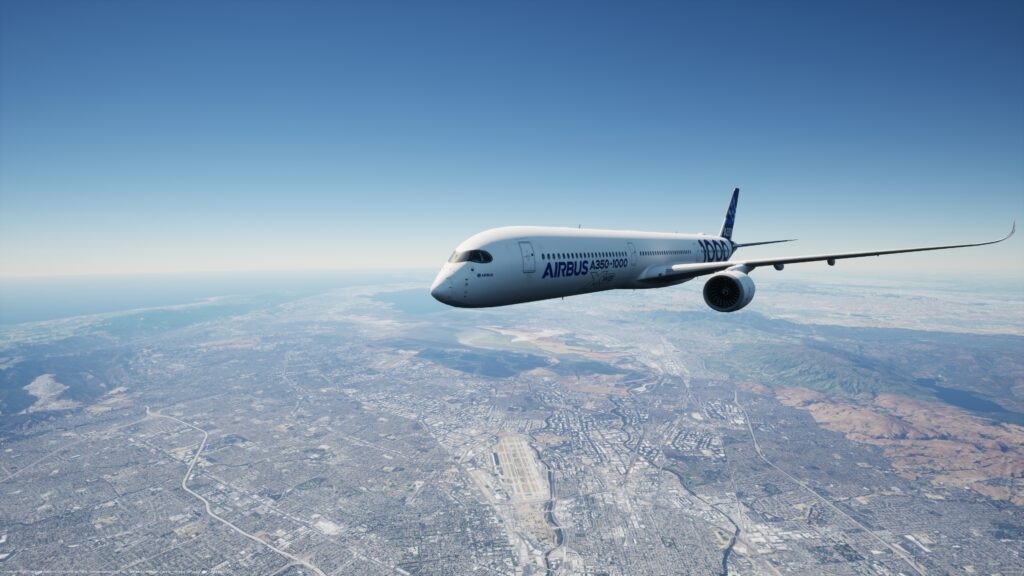
Airbus UpNext and Acubed are evaluating the use of automated technologies for pilot assistance. Pictured above is the A350-1000 flight lab. (Photo: Airbus/Acubed)
A wholly owned subsidiary of Airbus, called Airbus UpNext, announced recently that it has started testing new pilot assistance technologies with an A350-1000 test aircraft. Automated emergency diversion in cruise, automatic landing, and taxi assistance are the three technologies undergoing evaluation. The Airbus UpNext team aims to explore the use of autonomous flight systems to support operations with greater levels of safety and efficiency.
Acubed, the Silicon Valley innovation center of Airbus, collaborated with Airbus UpNext in 2020 to conduct autonomous taxiing, take-off, and landing with a commercial aircraft. The vehicle utilized image recognition powered by artificial intelligence technology developed at Acubed. The new demonstrator—DragonFly—was launched by Airbus UpNext (in partnership with Acubed) in 2022.
Airbus UpNext also announced that it is launching a project to advance next-generation computer vision-based algorithms in support of landing and taxi assistance.
“Vision-based machine learning is a key tech enabler for autonomous ground vehicles,” according to an article by engineer Cedric Cocaud about the role of data curation and data labeling for vision-based machine learning and AI.” Cocaud added, “It is able to accurately single out objects of interest in an image, reliably classify them and determine their precise position within the image.”
Arne Stoschek, Acubed’s Head of AI and Autonomy, explained in an interview with Avionics International that the objective of the DragonFly demonstrator is to explore new technologies for pilot assistance. “The main goal for looking at those technologies is to enhance flight safety and aircraft operational capabilities and efficiencies,” Stoschek said.

Developing machine learning algorithms to enable global coverage requires large quantities of data from a large number of airports. (Photo: Airbus/Acubed)
Acubed and Airbus UpNext are working together to enable an aircraft to perceive objects and events in its environment and to maneuver autonomously while maintaining safety. The partners are also looking at topics such as reducing pilot workloads, de-risking emergency operations, and enabling aircraft to communicate autonomously with air traffic management.
“We are working on developing the means to ensure these types of functions globally, at any airport where Airbus aircraft can land, and in any weather conditions,” Stoschek noted. He explained that they are looking at varying conditions—for example, approaching an airport at night is very different from a daytime approach. “At nighttime, approaching an airport, it’s pretty much an ocean of blinking light.”
Another topic that Airbus UpNext and Acubed are working on is global scalability. Key to addressing this is the “availability of artificial intelligence—specifically machine learning technologies for perception,” he said. “That’s a specific technology developed in other applications, such as for autonomous driving applications, that we make useful for our specific application of flight.”

DragonFly is a demonstrator developed by Airbus UpNext to explore new pilot assistance technologies that can advance flight safety and aircraft operational efficiency. (Photo: Airbus UpNext)
Quick iteration and prototyping are two central development paradigms at Acubed. Stoschek explained, “This approach allows rapid development, iterative software development processes, and connecting the technologies to the requirements of the aircraft.”
Developing machine learning algorithms to enable global coverage requires large quantities of data from a large number of airports. “It’s a very large scale data processing topic to automatically process the data—to train the machine learning algorithms, data has to be in a specific format and needs to be annotated,” Stoschek commented.
There are essentially two methods to accumulate the large amounts of data necessary. The first is to conduct flights and collect data directly, which comes with concerns about cost and availability, Stoschek said. The other method is synthetic data generation. Acubed uses computer-based technologies, including a digital twin, to recreate or generate data. Testing different situations such as noncooperative traffic would be very expensive without the use of simulation and collection of synthetic data.